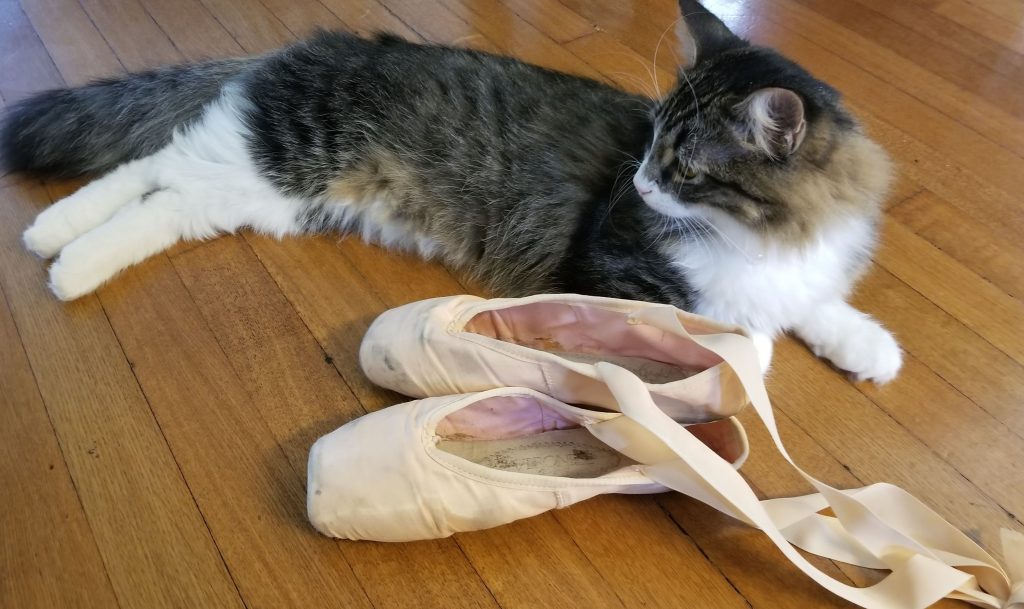After my World Ballet Day post, one of my dedicated subscribers mentioned that she thought that the video of the ballerina prepping her pointe shoe video was very interesting and wanted to learn more. So today, I will attempt to briefly explain pointe shoes.
A ballet slipper is a soft shoe worn by all ballet dancers. This type of shoe has a flexible, soft sole and is secured to the foot with one or more elastic straps. Ballet slippers can be made of leather, canvas, or satin and are usually a flesh-colored pink (ballet pink) or black.
A pointe shoe is generally only worn by grown ballerinas. It is the same sort of shape as a ballet slipper with small but significant differences. First is a rigid toe box that is flat on the end. This is the “point” that the ballerina dances on. The box is made from layers of paper and/or fabric that are stiffened with glue. The shank of a pointe shoe functions to stiffen the sole and provides support to the arch of the foot when on pointe. The shank can be made from layers of burlap, cardstock, or leather that is again hardened with glue. A pointe shoe is secured to the foot with satin ribbons.
One important part of both ballet slippers and pointe shoes is the vamp. Both types of shoes will have a vamp that is high enough to cover the metatarsal phalangeal joints (where your toes meet your foot). This provides important support to those joints which is particularly important for dancing on pointe.
The shape of the toe box and the hardness of the box and the shank vary among brands and models of pointe shoes. One brand, Freed, has each shoe marked by the shoemaker as there can be variations that certain dancers prefer. I never wore Freeds, but on more than one occasion I did witness a gal trying to find two shoes in her size from her preferred maker at the dancewear store (it was a big deal).
During my years of dancing on pointe, the brand and style of shoe I preferred evolved. I began with the Capezio Contempora, which has a tapered toe box with a long, V-shaped vamp and a firm shank. I have a very high arch, so the long vamp and the firm shank supported my foot well.
Eventually, I switched to the Chacott Coppelia II, which were made in Spain. I can’t remember why that was such a big deal, but I do remember that it mattered. The Coppelia II was similar to the Contempora, but the big difference that made me switch was that it had a flatter toe box. This meant that my toes were more constricted in the shoe which meant less rubbing (that is a good thing).
My last pointe shoes were Chacott Veronese, which are made in Japan. The Veronese are more lightweight; they have a shorter, more square-shaped toe box with a firm shank. By that point in my life as a dancer, my feet were very strong, but I was starting to feel the years of wear-and-tear. The lighter box took a lot of pressure off of my metatarsal phalange joints, particularly on my big and pinky toes.

And that is a brief discourse on pointe shoes. Let me know if you would like me to do another post in the future to talk about how ballerinas prepare their pointe shoes.
By the way, get excited – Ballet Season is almost here!


Interesting. I saw a news show years ago that profiles a shoe maker and how he had been making shoes for the same ballerina’s for years. It had never occurred to me how big a deal that would be, even though as a figure skating fan I was aware that figure skaters are just as particular about their boots and blades. Would love to hear more about how ballerinas prepare the shoes.
I was never as serious of a dancer as you were but I do remember that if I didn’t break the shank if my shoes in correctly, then I definitely felt it in my toes by the end of class.
Where can you purchase Chacott Copellia II now. Can’t find them.
When I was researching for this post, I got the impression that they might have been discontinued.